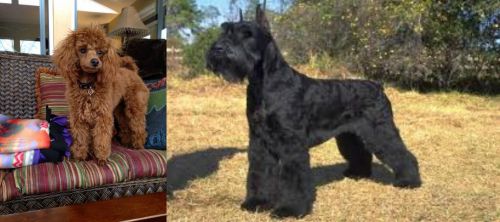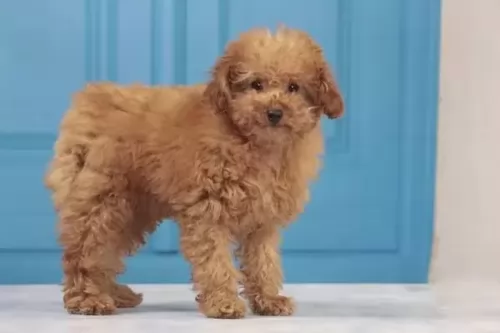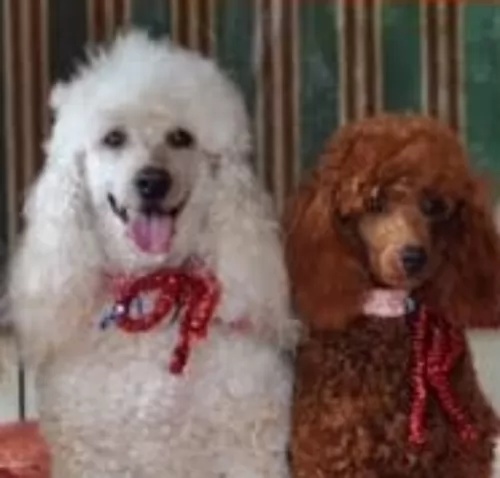 MyDogBreeds
MyDogBreeds Both Miniature Poodle and Giant Schnauzer are originated from Germany. Miniature Poodle may grow 32 cm / 12 inches shorter than Giant Schnauzer. Miniature Poodle may weigh 40 kg / 88 pounds lesser than Giant Schnauzer. Miniature Poodle may live 4 years more than Giant Schnauzer. Both Miniature Poodle and Giant Schnauzer has almost same litter size. Both Miniature Poodle and Giant Schnauzer requires Moderate maintenance.
Both Miniature Poodle and Giant Schnauzer are originated from Germany. Miniature Poodle may grow 32 cm / 12 inches shorter than Giant Schnauzer. Miniature Poodle may weigh 40 kg / 88 pounds lesser than Giant Schnauzer. Miniature Poodle may live 4 years more than Giant Schnauzer. Both Miniature Poodle and Giant Schnauzer has almost same litter size. Both Miniature Poodle and Giant Schnauzer requires Moderate maintenance.
 The Poodle is no stranger to the dog world and has been a familiar face in Western Europe for hundreds of years. Though they have lived in Europe for centuries, their origins are unsure, with some saying they hail from Germany and others say France.
The Poodle is no stranger to the dog world and has been a familiar face in Western Europe for hundreds of years. Though they have lived in Europe for centuries, their origins are unsure, with some saying they hail from Germany and others say France.
The Miniature Poodles have been used in both countries as gundogs for water birds.
They have always been admired for their intelligence, and Miniature Poodles are believed to have been bred from Standard Poodles. It is interesting to note the 3 official sizes of the Poodle are Toy, Miniature and Standard – all considered one breed and judged according to the same written standard, just with different size requirements.
 As a working dog breed, the Giant Schnauzer, known also as the Riesenschnauzer, hails from Germany.
As a working dog breed, the Giant Schnauzer, known also as the Riesenschnauzer, hails from Germany.
It is believed that the first Giant Schnauzers emerged in Bavaria in the 17th century already. It is the largest of the 3 Schnauzer dogs – Miniature, Standard and Giant. There are quite a few breeds which have been used in its development – Bouvier des Flandres, Great Dane and the German Pinscher among other.
The dog was bred to work on farms and also used as a military dog during the World Wars.
 With good care the lifespan of the Miniature Poodle is 14 – 16 years of age. This purebreed dog is small, standing at 28 – 38cm in height and weighing 7 – 8kg.
With good care the lifespan of the Miniature Poodle is 14 – 16 years of age. This purebreed dog is small, standing at 28 – 38cm in height and weighing 7 – 8kg.
The coat is typically curly, springy and dense. Colors of the coat can be cream, beige, silver, black, brown or apricot. They are low shedding dogs and are regarded as being hypoallergenic. The ears are floppy and the tail is usually docked to give the dog a nice, compact look.
The Miniature Poodle is intelligent and learns easily, so you won’t have any trouble with training him and having him socialized.
He is a lively dog and loves a game and a walk, loving as much time as possible spent with his human family. He gets on well with other pets in the home as well as with children who have been taught to be kind and gentle with animals.
They are not overly-friendly with strangers, and therefore make excellent watchdogs. They’re the kind of dogs who need both physical and mental stimulation though, and he won’t be content to be left and ignored – after all he counts himself as a member of your family! They make wonderful pets, being playful and energetic and loving water, always ready to swim with you.
 With a thick, medium length double coat to protect him from the weather, the Giant Schnauzer’s coat is essentially wiry and hard and in solid black or in a greyish salt and pepper color.
With a thick, medium length double coat to protect him from the weather, the Giant Schnauzer’s coat is essentially wiry and hard and in solid black or in a greyish salt and pepper color.
The dogs have always traditionally had their ears and tails docked at the 2nd or 3rd joint to set them apart in looks, but these days both the ears and tail are left.
The tail is always held high. He has dark eyes. Like all Schnauzers, they have that distinct beard and eyebrows. The dog is large and well built and stands at 60 to 70cm in height and weighs anything between 25 and 48kg.
Intelligent, strong willed and energetic, the Giant Schnauzer is actually a quiet dog who doesn’t respond too well to strangers, being reserved around them.
He has a natural guarding and territorial instinct. When he is trained and socialized he makes a wonderful pet, responding well to a firm, consistent owner.
He loves his human family, and as a stable, reliable kind of dog, whether you’ve got children in the home, pets or elderly people, you can rely on your Giant Schnauzer to be a dependable, gentle pet at all the right times, being playful and energetic at other times.
 When you take a Miniature Poodle into your home and your heart, there are many wonderful positive aspects that come with him.
When you take a Miniature Poodle into your home and your heart, there are many wonderful positive aspects that come with him.
You won’t have any trouble training him as he is clever and bright. He is such a loving, loyal pet and he takes his job of guarding you seriously too.
Because they aren’t aggressive, they're easy to keep in the city or the countryside, so long as he receives plenty of love, companionship and exercise. Perhaps the only thing that may require a little bit of effort on your part is the fact that his coat will require quite a bit of upkeep to keep it looking good and healthy.
In exchange for looking after him, you’re going to benefit from having a wonderful canine friend and family pet in your life for many years.
 The Giant Schnauzer has many excellent characteristics which make it such a great pet. He is composed, alert, intelligent, loving and loyal to his human family.
The Giant Schnauzer has many excellent characteristics which make it such a great pet. He is composed, alert, intelligent, loving and loyal to his human family.
He is also playful, being happiest when roped into everything going on in the family. He has a solid, balanced nature, is robust and hypoallergenic.
He is powerful and needs a good dose of exercise and will love to join you on your cycle- and hiking trips. Good with children and pets in the home, this is a dog breed that will make a splendid, reliable pet.
 Dog’s thrive on good nutrition and exercise, and if your Miniature Poodle gets both of these combined with plenty of love, he can live to be up to 16 years of age and even older.
Dog’s thrive on good nutrition and exercise, and if your Miniature Poodle gets both of these combined with plenty of love, he can live to be up to 16 years of age and even older.
They are robust little dogs, but even so, they can get sick. Ear infections, joint diseases, obesity, dental disease and bloat are common dog diseases to look out for -
This is a life-threatening condition where your pet’s stomach fills with gas. The swollen stomach puts pressure on the diaphragm and the dog battles to breathe. The dog could also vomit, be drooling and lethargic.
The stomach can also twist putting the dog in shock. This bloating can occur with any dog breed and efforts can be made to avoid it by feeding the dog smaller more frequent meals as opposed to one larger meal which he gobbles up.
The dog shouldn’t exercise immediately after a meal either. You also want to avoid obesity at all costs.
When the mitral valve malfunctions, blood isn’t being pumped out of the heart to the rest of the body. If the mitral valve weakens or leaks it can lead to endocarditis.
Quite a number of dogs develop some form of heart disease during their lifetime, with a high percentage being due to mitral valve insufficiency, which is more common in smaller dogs.
Your dog may have a cough, be lethargic and lose weight. The first signs of a leaking mitral valve is a heart murmur. At first MVI doesn’t have obvious clinical signs, but with time the efficiency of the heart is reduced and congestive heart failure develops. Your veterinarian will evaluate your pet and suggest treatment.
A skin problem sounds fairly mild but it can cause havoc in your pet’s life, causing him to be constantly licking and scratching himself. The hair becomes dull and brittle, and breaking the skin from continuous scratching invites bacterial infection. These skin infections will require veterinary intervention.
 A healthy Schnauzer can reach 10 – 12 years of age, but even so, they are a dog breed prone to high rates of hip- and elbow dysplasia, hereditary eye disease and thyroid disease.
A healthy Schnauzer can reach 10 – 12 years of age, but even so, they are a dog breed prone to high rates of hip- and elbow dysplasia, hereditary eye disease and thyroid disease.
Blood-clotting diseases and epilepsy are also concerns with Giant Schnauzers as well as bloat. As with all deep-chested breeds, Giant Schnauzers are more at risk with this gastrointestinal syndrome known as bloat and which can be life threatening.
It is your right to ask the breeder about the medical history of your puppy’s parents.
 If you opt to keep your Miniature Poodle’s coat long, it will actually require regular brushing – every day in fact, if you want to avoid matting and tangling. Most people don’t like the work this involves and they have their Poodle’s hair cut short all over, then he only needs a brush once or twice a week. Your Miniature Poodle just loves the time you spend with him grooming him. It’s your time to feel for any unusual lumps and to also check for fleas and ticks. Some people take their pet to the doggy parlor to have the coat clipped.
If you opt to keep your Miniature Poodle’s coat long, it will actually require regular brushing – every day in fact, if you want to avoid matting and tangling. Most people don’t like the work this involves and they have their Poodle’s hair cut short all over, then he only needs a brush once or twice a week. Your Miniature Poodle just loves the time you spend with him grooming him. It’s your time to feel for any unusual lumps and to also check for fleas and ticks. Some people take their pet to the doggy parlor to have the coat clipped.
The dog’s nails should also be trimmed regularly, and their ears also need to be checked for wax buildup and debris which can lead to an ear infection.
Teeth need to be checked over too because dental disease won’t only lead to loss of teeth but it could be toxic for important body organs too.
Wipe around your pet’s eyes as tear stains can form under the eyes.
Make sure to feed your pet a top quality diet full of vitamins and minerals. Get to know the foods which can be toxic for your pet and cause stomach upsets. Dogs appreciate simplicity and consistency with their diets, and apart from dry kibble, home-made food such as boiled chicken, brown rice and vegetables can be excellent for your pet.
 He is a particularly low shedding dog and so brushing him twice a week will suffice. He loves the closeness with his human family during these grooming sessions.
He is a particularly low shedding dog and so brushing him twice a week will suffice. He loves the closeness with his human family during these grooming sessions.
If you don’t know how to groom yourself, the Giant Schnauzers coat will require hand-stripping or clipping. If you want to keep your dog with that typical Schnauzer look, a visit to a professional groomer will be required as they will also tidy the hair around each paw as well.
Now that the ears are no longer cropped, he has fairly short floppy ears and it will be necessary to ensure that dampness, ear wax and dirt don’t build up to cause ear infections.
The teeth must also be brushed 2 or 3 times a week otherwise plaque buildup can cause dental disease as well as lead to other more serious diseases such as kidney- and heart disease.
If you’re a new dog owner, it can be hard to know which dog food to buy and which ingredients to look out for. Nutrition is of vital importance, and bad ingredients can make your dog sick and shorten his life.
A mix of the best commercially manufactured kibble mixed with home-made food full of the right balance of vitamins and minerals will be important as well as including some raw meat into the diet.
If in any kind of doubt about how to feed a large, energetic dog breed like this Giant Schnauzer, speak to your vet.
As a big, energetic dog, the Giant Schnauzer needs to live on a property where there is a garden. He will be requiring some hectic exercise every day.